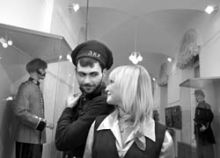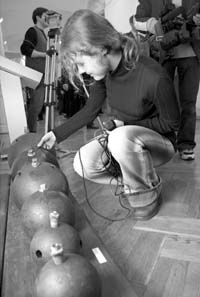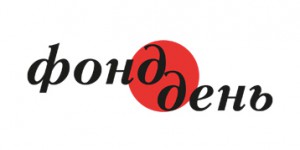The launch of the exhibit “Crimean War: Ukrainian Heritage,” based on the Sheremetyev family collection, took place at the University Art Gallery at Taras Shevchenko National University. The exposition commemorates the 150th anniversary of the Crimean War (1853-56), which is being officially observed in Ukraine this year.
The Crimean War, also known as the Eastern War, is considered the largest European military conflict of the late nineteenth century, involving Russia, Great Britain, France, the Ottoman Empire, and the Italian Kingdom of Sardinia. The bloodiest battles were fought in the south of Ukraine, particularly at Sevastopol. An important fact to note is that ethnic Ukrainians made up one-third (some historical sources point to half) of the Russian army. Apart from soldiers and sailors — conscripted serfs — ethnic Ukrainians were commanding and general officers, members of aristocratic families from the Kyiv, Chernihiv, Poltava, Tavria, and Kherson gubernias. According to Ihor Sheremetyev, co-owner of the collection, specific names can be identified, including those of Kyiv residents, as well as their real estate, buildings that are still standing on Zhylianska St. Many Ukrainian combatants were buried in Kyiv cemeteries. The captions of photos on display are graphic proof of Ukrainian bravery under enemy fire: “Heroic defenders of Odesa in April 1854: bombardier Oleksiy Moskalenko and private Denys Yunikov of the Zhytomyr Light Infantry Regiment “; “Boatswain Stepan Rudenko hero of Sevastopol defense”; “Sevastopol defenders Ivan Dymchenko, Fedir Zayika.” Commander Oleksandr Zavadovsky and sailors Petro Kishka and Ihnatiy Shevchenko particularly distinguished themselves in combat. And to think of all those unidentified heroes fallen in battle! The only reminders of them are some personal effects, fragments of uniforms of the Poltava Infantry Regiment, the 23rd Ukrainian and Zhytomyr Light Infantry Regiments.
The exposition features more than 4,000 rare items, including fragments of authentic uniforms and military equipment of officers and men from both warring sides, buttons, insignia, military decorations, epaulets, samples of full-dress uniforms, compasses, field glasses, objects of daily use (water bottles and flasks), weapons (knives, swords, rifles, grenades), photographs, and coins.
The Sheremetyev collection is the largest of its kind in Ukraine. It all started more than twenty years ago. While vacationing in the Crimea, Ihor and Oleksiy Sheremetyev bought several Russian regimental buttons at a local antiques bazaar. The buttons dated from the Crimean War and the brothers purchased them as souvenirs. “But then we became increasingly interested in this historical period and began collecting items of military and daily use,” says Oleksiy. “We began corresponding with other collectors and traded our finds, we visited curiosity shops, looking for things that had some value at the time, and bought them from private individuals; we visited former battlegrounds and worked in the archives of numerous Ukrainian museums. After joining the British Crimean War Research Society, we visited the National Army Museum in London and the Hotel des Invalides in Paris. Both have special exhibition halls dedicated to the war. We even embarked on scholarly cooperation to a degree.” On display at the museum in London is a full-dress uniform once worn by a surgeon of the 70th British Infantry Regiment. Although the unit did not take part in the Crimean War, the surgeon was dispatched to Balaklava and assigned to a military hospital. After working there for a while, he fell ill and died. His personal effects and uniform were sent to his parents, who donated all of his effects to the museum. A button belonging to an officer of the 70th British Regiment was found in Balaklava on the site of the hospital (every regiment had its own uniform, number, and epaulets). Considering that only one officer from this regiment was on the hospital staff, it is safe to assume that the button belonged to the surgeon.
Among the especially valuable items in the collection Ihor Sheremetyev mentions a silver French cavalry eagle that was once attached to a soldier’s field bag, a tag on a parcel addressed as “Colonel Arnold Lawrence for the soldiers of the 2nd Battalion of the Rifle Brigade near Sevastopol,” and mines and grenades. Interestingly, the first antipersonnel mines used in that war were manufactured by Kyiv’s Arsenal Plant. Gunpowder and artillery pieces were also supplied by Ukrainian factories. The Sheremetyev brothers are convinced that visitors will be interested in learning more about Ukrainian heroism, even though all those Ukrainians fought in a foreign war, not the first time and certainly not the last. The exhibit ends on December 7.









